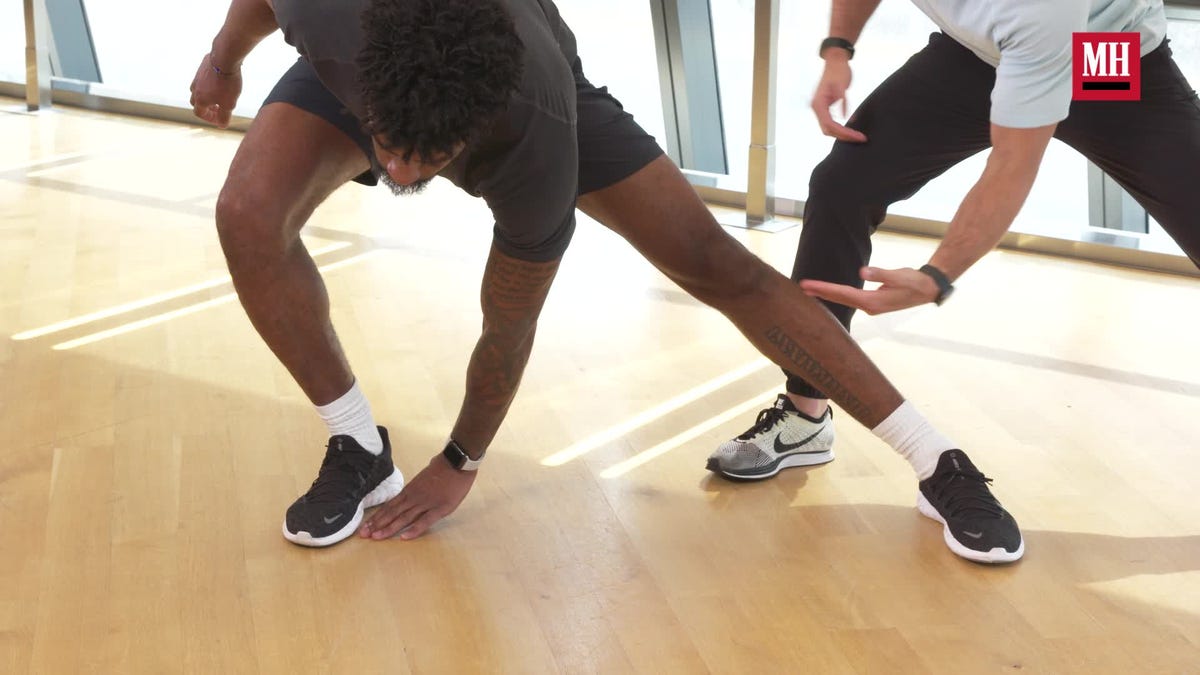RUNNERS CAN EASILY fall into a basic routine for their workouts: Lace up, hit the pavement, then cruise at a comfortable pace for as many miles as planned. This might feel good, but it’s not always the best way to maximize your gains to get faster.
In the same way switching up the types of exercises you do in the gym will help you avoid performance plateaus and get stronger faster, varying how fast and slow you run—throughout a week of training, and even within the same workout—can help you to supercharge your running. One of the best ways to do that is with a style of workout called interval training.
What Interval Training Means for Runners
Most runners focus on racking up mileage when they start running. Taking that approach to build your aerobic base is useful, even for the most seasoned competitors; the volume of easy runs was most correlated with world-class long distance running performance scores in a 2021 study published in the Journal of Strength and Conditioning Research.
But once you’re comfortably running a few miles at a consistent clip multiple times per week, occasionally changing up your pace with speed work will help you start to see more progress. “Interval training is essentially just alternating between running at a faster, challenging pace for a specific duration, then slowing down to a more comfortable pace for active recovery for a certain duration,” explains Ackeem Emmons, a USATF-certified running coach and NASM-certified personal trainer for Tonal.
How you break a workout up between those periods of work and rest depends on your fitness level and goals, says Nick Savin, a certified running coach and ACE-certified personal trainer. “If you’re learning to run, you might run for four minutes, walk for one, and repeat that six times to help allow our body to adapt to the demands of extended running,” he explains. “If you’re more experienced, you might want to increase your speed on the four minutes of work while keeping your rest to either an easy jog or a walk.”
The Benefits of Interval Training for Runners
Almost every training plan for race distances from a mile to a marathon will incorporate some level of interval training, because science has consistently shown that it it makes you a better runner.
For starters, “interval training can be an effective way of fitting a hard-hitting workout into a shorter amount of time,” says Savin. You’re also getting more work done at a higher intensity than you would on a steady-state run, even with the recovery periods. “By practicing these higher intensities at durations shorter than the time to burn out, you can better train your body to be able to adapt to and maintain higher speeds,” he adds. Translation: Your overall pace will improve.
And just because you’re going faster, that doesn’t mean your gains won’t apply to longer distances. Sprint interval training significantly improved runners’ 3,000-meter time, extended their time to exhaustion, and improved their power in a small 2017 study published in The Journal of Strength and Conditioning Research.
This may sound counter-intuitive, but incorporating interval training can also help build endurance, says Emmons. By alternating work and recovery periods, you’re improving both your anaerobic system (which doesn’t require oxygen for short bursts of effort) and aerobic system (which uses oxygen to power longer, lower-intensity efforts). While faster intervals can help you build speed and power, the recovery intervals allow your body to reset so you can get in more quality reps. Over time, you’ll not only be able to run faster—you should also be able to hold that pace for longer periods.
Short bursts of speed also engage your muscles differently, activating fast-twitch muscle fibers, which are responsible for generating strength and power, versus slow-twitch muscle fibers, which help sustain you during those longer, lower-intensity efforts.
One more major benefit: Interval training has been shown to help lower your risk of injury. Marathoners who incorporated intervals into their training were found to be less likely to get hurt than those who didn’t in a 2016 study of almost 1,000 runners published in the Scandinavian Journal of Medicine & Science in Sports.
How You Can Use Interval Workouts
“You should approach interval training as a ratio,” says Emmons. “Think ‘work to rest’: 1:1, 2:1, 3:2; the possibilities are endless depending on your goals.” Different interval lengths improve specific aspects of our fitness, or “the power or size of different engines,” says Savin.
To build a foundation of strength and power, for example, “you might try running short bursts at 400 meters at a relatively strong pace, like 5K race pace,” says Savin. “This allows us to practice staying strong for extended periods of time—and taking the interval approach allows your 5K strength to last longer than a 5K itself, because you’re including recovery periods.”
When you’re training for longer distances, “you might extend the work duration to 1,200 meters (not too far off from a mile) at a half marathon pace,” says Savin. “Longer periods of running under a degree of fatigue also help to replicate feelings more effectively of race day.”
If you don’t know your race paces, that’s okay. “I typically use a scale of 1 to 10 for rate of perceived exertion, with one being the easiest effort and 10 being the hardest,” says Emmons. Shorter intervals would correspond to an eight to 10 on that scale, while longer reps would call for an effort level somewhere between five and seven.
How you approach your recovery intervals matters, too. “Ultimately, what you do during your rest depends on the objective of the workout itself,” says Savin. “If your goal is more about power and speed, you likely want short work periods and longer rest periods with something closer to a walk to allow the body to completely refill to repeat maximal efforts. But if you’re looking for more of an endurance benefit, you’ll extend the work periods while decreasing the amount of rest in order to keep your heart rate and oxygen demand up.”
Think of interval training as a strategic tool to deploy within your weekly training. How often you do these workouts “absolutely depends on the person, their fitness level, their goals, and the application of the intervals themselves,” says Savin. “Someone who is just starting out in their running journey might have two or three days a week of lower-intensity intervals with many rest periods of walking or even standing, while someone who has been running consistently for a while may only have one higher-intensity day of interval work.”
The higher the overall intensity of the interval workout, the longer you’ll need for recovery—and rushing into another workout instead of just going out for an easy steady-state run can overwork your body and put you at risk for injury.
4 Interval Running Workouts for Better Training
Not sure where to start? Savin and Emmons put together a few simple interval workouts for runners of all levels. You can do these outside or on a treadmill, but make sure to warm up and cool down at an easy pace for 10 to 20 minutes before and after a workout.
Beginner Interval Workout
This is meant for beginners, says Savin, but you could also do this any time you’re easing back into workouts after a race or just looking for something simple to vary your paces.
How to Do It:
- 2:00 at seven out of 10 effort
- 2:00 walking recovery
- Repeat six to eight times
Pyramid Workout
“In this endurance-building interval workout, you’ll move between tempo pace (a five to seven out of 10 effort level) and an easy jog,” says Emmons. Throughout the workout, the amount of time you’re holding that effort for will increase to a point, and then decrease back to your starting duration.
How to Do It:
- 1:00 @ tempo pace, followed by 1:00 jogging
- 2:00 @ tempo pace, followed by 1:00 jogging
- 3:00 @ tempo pace, followed by 1:30 jogging
- 4:00 @ tempo pace, followed by 2:00 jogging
- 3:00 @ tempo pace, followed by 1:30 jogging
- 2:00 @ tempo pace, followed by 1:00 jogging
- 1:00 @ tempo pace, followed by 1:00 jogging
Long Interval Workout
Runners training for longer distance races can benefit from workouts that improve their VO2 max, says Savin. Improving your VO2 max—or the maximum amount of oxygen your body can use during intense exercise—directly influences your aerobic capacity and ability to sustain a prolonged effort over time.
How to Do It:
- 1,200m at 5K pace (or an eight or nine on a scale of one to 10)
- 3:00 rest
- Repeat four to five times
Short and Speedy Interval Workout
“The focus here is on form, power, and consistency,” says Emmons. You’ll notice that as the duration of the work intervals decreases, the time for rest increases. “As we work, fatigue is inevitable, so to optimize performance, we allow more rest,” he explains.
How to Do It:
- Sprint for 40 seconds
- 2:00 active recovery (walking, easy jog, dynamic stretches)
- Repeat three times
- Sprint for 30 seconds
- 2:30 active recovery (walking, easy jog, dynamic stretches)
- Repeat three times
- Sprint for 20 seconds
- 2:30 active recovery (walking, easy jog, dynamic stretches)
- Repeat three times
Read the full article here



